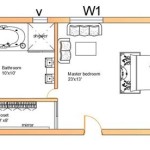Where Can I Find The Original Building Plans For My House?
Obtaining the original building plans for a house can be a valuable endeavor for various reasons. Whether planning renovations, investigating structural issues, or simply seeking historical documentation of the property, accessing these plans provides a wealth of information. Locating these documents, however, can be a process that requires patience and a strategic approach, as the information may reside in various locations. This article will outline the primary sources where homeowners can attempt to find the original building plans for their house.
Local Government Archives and Building Departments
The primary repository for residential building plans is typically the local government. Most municipalities require the submission and archival of building plans as part of the permitting process. This is often managed by the city or county's building department, planning department, or a dedicated archives division.
The first step should be to contact the local building department. They can provide information regarding their record-keeping practices, including the process for accessing archived building plans. Inquiries should include the property address, the year the house was built (if known), and any relevant permit numbers that might be associated with the property. The more information that can be provided, the easier it will be for the department to locate the correct records.
Be prepared for variations in how records are stored. Some municipalities have digitized their records, allowing for online access via a searchable database. Others maintain physical archives, requiring an in-person visit to review the documents. If the records are maintained physically, it is common for the building department to require an appointment to access them. Furthermore, there may be fees associated with accessing, copying, or retrieving these documents.
It’s important to note that older records might be incomplete or poorly organized. The likelihood of finding plans for a house built in the early 20th century, for example, may be lower than for a house built more recently. Record-keeping practices have evolved over time, and older documents may have been lost or damaged due to age, natural disasters, or inadequate storage conditions. Even when plans are available, they might be in a delicate condition and require careful handling.
When contacting the building department, inquire about any restrictions on accessing the plans. Some municipalities may have policies in place to protect the privacy of previous owners, limiting access to certain information or requiring proof of ownership before releasing the documents. In some cases, redaction of certain details may be necessary before the plans can be released.
If the building department is unable to locate the plans, inquire about any other departments within the local government that might hold relevant records, such as the planning department or the historical society. These departments may have separate archives or databases that contain building plans or related documents such as property surveys or subdivision maps.
Architectural Firms and Construction Companies
Another potential source for original building plans is the architectural firm or construction company that designed and built the house. If the name of the architect or builder is known, contacting them directly could prove fruitful. This is particularly relevant for custom-built homes or houses designed by well-known architects.
Researching the history of the property might reveal the names of the firms involved in its construction. Local historical societies, libraries, and online resources such as historical property databases can provide valuable information about the architects and builders who worked in the area during the period when the house was built. Land records might contain information about the builder or a prior owner who commissioned a new home design.
Once the name of the architectural firm or construction company has been identified, attempt to locate their contact information. Many firms have websites or online directories that can provide their current address and phone number. If the firm is no longer in business, research its history to see if it was acquired by another company or if its records were transferred to another organization. Trade associations or professional organizations related to architecture and construction might also be able to provide information about the firm's history and its current whereabouts.
When contacting the architectural firm or construction company, explain the reason for the request and provide as much information as possible about the property. Be prepared to provide proof of ownership and to sign a release form acknowledging that the firm retains copyright over the plans. The firm may charge a fee for retrieving, copying, or releasing the documents. Even if the company no longer holds the plans, they might be able to provide information about where they were archived or who might have access to them.
It's important to recognize that architectural firms and construction companies are not always obligated to retain building plans indefinitely. Their retention policies may vary, and older records may have been discarded or lost over time. However, it is still worthwhile to contact these firms, as they may be able to provide valuable insights or leads that can help locate the original plans.
Title Companies, Previous Owners, and Estate Records
While not always reliable, title companies, previous homeowners, and estate records can sometimes provide leads or even copies of the original building plans. These avenues require a more investigative approach, but they can be particularly useful when other sources have been exhausted.
Title companies often conduct extensive research on property records, including deeds, mortgages, and other legal documents. While they may not routinely retain copies of building plans, they might have encountered them during their research and could provide information about where they were originally filed. Contacting the title company that handled the property's most recent sale or transfer could be worth the effort.
Reaching out to previous owners of the property is another potential avenue. They may have retained copies of the building plans from when they owned the property or may know where the plans were stored. Contact information for previous owners can sometimes be obtained through property records or by contacting neighbors who have lived in the area for a long time. When contacting previous owners, be polite and respectful and clearly explain the reason for the request. Offer to compensate them for their time and effort if they are able to locate and provide the plans.
Estate records, such as wills and probate documents, can sometimes contain information about the property, including references to building plans or architectural drawings. These records are typically maintained by the local probate court or county clerk's office. Accessing estate records may require obtaining a court order or paying a fee. However, if there is reason to believe that the original owner of the house retained copies of the building plans, searching estate records could be a worthwhile endeavor.
Searching these sources requires patience and diligence. There is no guarantee that any of them will yield the desired results. However, by pursuing all available leads and employing a systematic approach, the chances of locating the original building plans for a house can be significantly increased. The success of this endeavor often depends on the age of the house, the record-keeping practices of the local government, and the willingness of previous owners and other parties to cooperate.

How To Get Blueprints Of Your House

Archimple How To Get Blueprints Of My House The Complete Guide

Find House Plans For Your Old Blueprint Search Nethouseplansnethouseplans

A Collection Of 1800s Home Designs With Floor Plans From One My Library Reference Books Published Vintage House Basement

Original Building Plans For My House With Two Floor Modern Home Design Photos N

Custom House Floor Plan Design I Modern Plans Home

My House Original Floor Plan It S Nothing Like This Now Victorian Plans Vintage

Vignette Design Bucket List 7 Build A House From Scratch

Design House Plan And 2d Floor Plans With Autocad By Archi Home Fiverr

This Is My House Basic Layout Some Of The Rooms Are Diffe Kit Homes Vintage Plans Farmhouse
Related Posts








